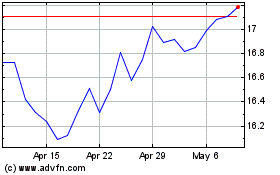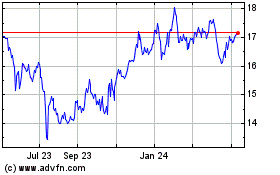By Mike Shields and Suzanne Vranica
AT&T Inc.'s $85.4 billion acquisition of Time Warner Inc.
does more than create a behemoth in media content creation and
distribution. Executives have said the deal also promises
innovation in advertising.
While ad industry executives love hearing such talk, it is
unclear exactly what it will mean.
The combination of AT&T and Time Warner brings together huge
amounts of viewing data with content, which could serve as a
catalyst to make TV advertising a lot more targeted to individuals
like digital advertising.
In addition, AT&T's vast pool of data from its 90 million
wireless subscribers as well as DirecTV households could be
leveraged to target people with ads across devices, including TVs,
laptops and mobile phones, some ad executives speculate.
Both approaches are potentially powerful for marketers but not
without hurdles, including privacy concerns.
Cable and satellite TV operators have long promised a world
where marketers would be able to target TV commercials to
individual homes. Addressable, or targeted, advertising uses
set-top boxes to route commercials to specific households or
neighborhoods based on data about income, ethnicity, gender or
other characteristics. For example, families with children could be
shown minivan TV ads while a single person in the same town could
be shown a TV spot for a sports car.
"Addressable advertising has been two or three years away for at
least 10 years now," said analyst Craig Moffett at
MoffettNathanson.
The tactic has historically been very manual to implement and
patchwork, limited to small pools of ad space in specific areas of
the country.
"It's been at the kids' table," said Tim Hanlon, a former
ad-agency executive and founder and CEO the Vertere Group, which
consults with ad and media companies. "It's been very difficult to
scale in a sizable way."
But AT&T Chief Executive Randall Stephenson said the merger
with Time Warner could change that, highlighting addressable TV ads
as a key opportunity offered by the deal.
"When you combine Time Warner's content with our scale and
distribution -- we have 100 million-plus TV, mobile, and broadband
subscribers -- you put that with our customer insights and the
addressable advertising opportunities that flow from that, we think
we build something here that's really special," Mr. Stephenson said
on a call with investors Monday. "It creates significant strategic,
as well as financial, benefits."
Currently, companies like AT&T are limited to running
addressable TV ads within the two minutes per hour of local
commercial time in cable programming sold by the pay-TV
provider.
If the deal goes through, AT&T could expand this to all of
the ad space on Turner networks like CNN -- albeit only in the
AT&T households with the capability.
It would give "addressable TV a significant increase in
inventory that advertisers can now buy," said Tracey Scheppach, an
executive vice president at Publicis Media, an ad-buying firm owned
by Publicis Groupe.
If that happens, ad executives said the deal could encourage
other cable giants to make addressable TV advertising more of a
priority.
"This deal could spark a break-wide-open moment for addressable
advertising," said Mr. Hanlon.
The dream is that addressable TV ads become more national in
nature, making them attractive to more advertisers.
That is a big "if." Major broadcast and cable networks control
their own national ad space and have been inclined to sell
expensive ads designed to reach large swaths of the country.
Brian Wieser, a senior research analyst at Pivotal Research
Group, said he is skeptical that there is a "meaningful opportunity
for addressable advertising at this time."
"Turner's advertisers generally need to buy their video/TV ads
cost-effectively, and need units that reach all parts of the
country, not only those who are AT&T subscribers," he wrote in
a note. "This means that enhanced ad units that AT&T may offer
when ads are delivered on its platform are of limited use if those
enhanced ad units are not available through other
distributors."
Although addressable TV advertising is growing rapidly -- it is
expected to more than double this year -- it is still a small piece
of the overall TV ad business. Advertisers are expected to spend
almost $1 billion, about 1.3% of TV ad spending, on addressable TV
ads in the U.S. this year, according to eMarketer.
A more national addressable TV ad footprint could be
kick-started by DirecTV's direct-to-consumer streaming offering
that is launching later this year, as well as other services aimed
at cord-cutters. Unlike the traditional pay-TV landscape, where
addressable TV ads are funneled through set-top boxes, TV delivered
over the internet allows for more weblike ad delivery that isn't
limited by region.
The other big potential advertising synergy to exploit is the
use of data to target consumers across screens, which would help
the company to more directly compete with Facebook and Google.
AT&T already delivers video ads on thousands of mobile apps
on 285 million devices through a partnership with mobile ad browser
giant Opera Mediaworks, for example.
"Targeting people from device to device is one of the most
vexing challenges in the marketing ecosystem today, and this
alignment would be a meaningful step in that direction," said David
Cohen, president of North America at ad-buying firm Magna
Global.
Theoretically, AT&T could take data on its wireless
customers, such as where they go and what apps they use, and couple
that with data from DirecTV households, such as where they live and
whether they have children. That information could be used to
target ads on Turner's websites and networks on TV and mobile
devices.
However, that won't be easy technically, and the combined
company would need to carefully explain to consumers why granting
permission to such tracking is to their benefit, said Mr.
Cohen.
Write to Mike Shields at mike.shields@wsj.com and Suzanne
Vranica at suzanne.vranica@wsj.com
(END) Dow Jones Newswires
October 24, 2016 16:13 ET (20:13 GMT)
Copyright (c) 2016 Dow Jones & Company, Inc.
AT&T (NYSE:T)
Historical Stock Chart
From Mar 2024 to Apr 2024

AT&T (NYSE:T)
Historical Stock Chart
From Apr 2023 to Apr 2024
